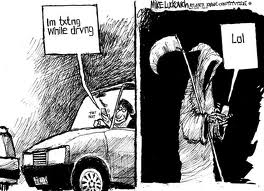Proving The Defendant Was Texting While Driving
 With so many accidents caused by distracted driving, it’s a fair bet that, in any given accident, the negligent driver was on a handheld phone or handling e-mail or text messages while driving. In many cases, that fact is not important: if the defendant admits liability, or if liability is clear (for example, the garden variety rear-end collision).
With so many accidents caused by distracted driving, it’s a fair bet that, in any given accident, the negligent driver was on a handheld phone or handling e-mail or text messages while driving. In many cases, that fact is not important: if the defendant admits liability, or if liability is clear (for example, the garden variety rear-end collision).
In other cases, though, proving that the defendant was distracted can go a long way toward showing that their version of events is likely wrong (if not an outright lie). Yesterday I deposed a representative of AT&T to find out everything I could about the phone usage of an automobile accident defendant at the time of the accident.
These types of depositions take a lot of legwork. When I get the transcript, I’ll post it on the website. If you have a case where you suspect illegal cell phone use at the time of an accident, here are some things to think about:
- Even before a lawsuit is filed, immediately send a preservation letter to save any cell phone owned by the defendant, and the content of any text messages on the phone at the time of the accident
- Either get the defendant to sign an authorization, or send a subpoena requesting all cell phone records (including voice, data and text messaging records) for the time of the collision
- Once you have those records, work with the cellphone carrier to set up a corporate designee deposition to decipher what the records mean–they typically come to you in spreadsheet form with various codes and abbreviations
- During the deposition, identify the meaning of every column and term generically
- During the deposition, figure out if you can verify whether there was any use of the phone during the collision
Find out what cell phone carriers and cell phone numbers the defendant had at the time of the collision
AT&T, for example, does not keep records of the content of text messages–they can only tell what time those messages were sent or received (they can’t tell what time the messages were read). In a catastrophic injury case, a forensic computer specialist may be able to dissect the phone to determine that type of information. Your best bet is showing a string of text messages back and forth near the time of the accident. Even better is a phone call log. Data usage (Apps, Facebook, internet usage) from a smartphone can be more difficult–many programs run in the background, so the fact that a phone is uploading or downloading data does not mean that someone is actively using the phone.
Finally, be sure to find out in discovery whether the defendant gets e-mail on his phone. If so, request a copy of all e-mail messages sent and received near the time of the accident.
 Maryland Car Accident Lawyer Blog
Maryland Car Accident Lawyer Blog

